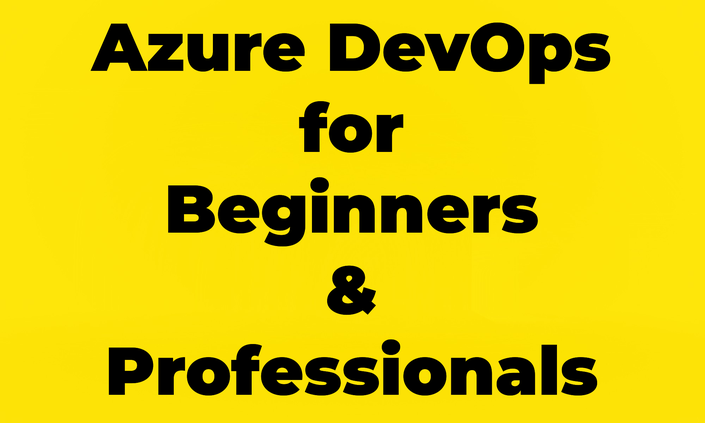
Azure DevOps Tutorial for Beginners & professionals
This course will teach you Azure DevOps right from basics to advanced like opening the Azure account and takes you to complicated build automation using Azure DevOps.
Lesson 1 :- Understanding DevOps Fundamentals, Agents, Boards, YAML Pipelines & Artifacts.
- Chapter 1:- Opening Azure DevOps account and creating project.
- Chapter 2:- DevOps Fundamentals and EIGHT structure life cycle of DevOps.
- Chapter 3:- Accessing Azure DevOps project from Azure portal.
- Chapter 4:- Understanding Organization, Project structure.
- Chapter 5:- Understanding Private and Public project.
- Chapter 6:- Mapping Boards, Repos, Pipelines, Test plan & Artifacts with DevOps life cycle.
- Chapter 7:- Revising the five important elements of Azure DevOps.
- Chapter 8:- Step 1 The planning phase :- Understanding Boards and work items.
- Chapter 9:- Step 2 Execution :- Checking Simple MVC project code, Cloning, Commit, Synch in Azure repos.
- Chapter 10:- Revising Azure DevOps life cycle using the 5 important elements.
- Chapter 11:- Flattening the Azure DevOps life cycle diagram.
Lesson 1.1 - Agents in DevOps, Define YAML, Understand YAML structure, Run Pipeline.
- Chapter 12:- Defining and Understanding Agents in Azure DevOps.
- Chapter 13:- Using project settings to configure agents.
- Chapter 14:- Hosted Agents and Local agents(Self hosted agents).
- Chapter 15:- Step 3 Build :- Creating pipeline and Running the pipeline.
- Chapter 16:- YAML file and versioning in Azure repos.
- Chapter 17:- Understanding the "No hosted Parallelism Error" in Azure DevOps.
- Chapter 18:- Understanding Self hosted agent and Agent pools.
- Chapter 19:- Running, Downloading, Extracting agents, Running Config & Entering PAT.
- Chapter 20:- Assigning Self hosted agents in YAML Pipeline.
- Chapter 21:- Running YAML pipeline with Self hosted agents.
- Chapter 22:- Definition and Acronym of YAML.
- Chapter 23:- YAML basics name/value, space indented, Nested objects & Hyphens.
- Chapter 24:- Understanding Azure DevOps YAML structure(Steps and Tasks).
- Chapter 25:- Practicing Pipeline UI:- Recent, All, Runs, Editing and seeing details.
- Chapter 26:- Updating YAML with publish task.
- Chapter 27:- Step 4 :- Running the pipeline and checking the artifact
- Chapter 28:- Drop folder, Extracting artifact, viewing the compiled binaries.
Lesson 2:- IIS Installation, Deployment Groups, Create and run Release Pipelines.
- Chapter 29:- Doing a Manual Review(Installing IIS and publishing the ASP.NET app)
- Chapter 30:- Creating the release pipeline.
- Chapter 31:- Understanding Deployment groups.
- Chapter 32:- Creating a deployment groups using PowerShell scripts.
- Chapter 33:- Creating release pipelines understanding stages.
- Chapter 34:- Step 5 :- Running the release pipeline and deploying.
- Chapter 35:- Revising the complete Azure DevOps Cycle.
Lesson 3 :- Create access variable, Diff Variables & variable groups, VSO Task.
- Chapter 36:- Variable definition, Creating and Accessing variables.
- Chapter 37:- Creating custom variable and read the same .
- Chapter 38:- Variable groups Definition, Creating variable groups.
- Chapter 39:- Defining Variable collection and accessing variable groups.
- Chapter 40:- Variable groups Definition, Creating & accessing variable groups.
- Chapter 41:- Variable vs Variable groups.
- Chapter 42:- Local variables outside the code.
- Chapter 43:- YAML variables vs variable groups vs local variables
- Chapter 44:- YAML Pipes Multi-scalar execution.
- Chapter 45:- Changing variable values using VSO Task.
- Chapter 46:- Why YAML variables change in next Step?
Lesson 4 :- Implementing CI CD Pipeline using Azure DevOps.
- Chapter 47:- Perspective of Dev Pipeline and Release Pipelines.
- Chapter 48:- Enabling CI CD in Azure DevOps
- Chapter 49:- Testing the Automation
- Chapter 50:- Solving ASPNetModule problem - Thinking out of the box.
Lesson 5 :- Executing Unit test in Azure Pipelines
- Chapter 51:- Nunit vs XUnit vs MsTest
- Chapter 52:- Writing the unit test
- Chapter 53:- Testing locally
- Chapter 54:- Using unit test task in pipeline
- Chapter 55:- Understanding the different parameters.
- Chapter 56:- Executing unit test using test task.
- Chapter 57:- Beware of the pattern matching
- Chapter 58:- Running pass , fail scenarios
Lesson 6 :- Parallelism, Stages, Jobs, Steps & Tasks - Pipeline Structure.
- Chapter 59:- Creating and understanding starters pipeline.
- Chapter 60:- Revising Steps, Scripts ,Tasks and YAML collections.
- Chapter 61:- Creating Stages, Jobs structure in YAML.
- Chapter 62:- Visualizing / Understanding Stages and Jobs.
- Chapter 63:- Stages VS Jobs.
- Chapter 64:- Demo of Stages and Jobs (Seqeuential).
- Chapter 65:- Visualizing from parallelism perspective.
- Chapter 66:- 3 points to remember for parallelism.
- Chapter 67:- Putting pauses and arranging agents.
- Chapter 68:- Demo of Stages and Jobs (parallelism).
- Chapter 69:- Implementing Dependencies between stages.
- Chapter 70:- Understanding Status Symbols.
Happy Learning, Happy Job Hunting !
Get enrolled from here - https://www.questpond.com/azure-devops-tutorial-for-beginners---professionals/cid91
Course Curriculum
-
PreviewLesson 1 - Azure DevOps Account, Create and Access DevOps Project, DevOps Lifecycle, DevOps Project Structure. (44:06)
-
StartLesson 1.1 - Agents in DevOps, Define YAML, Understand YAML structure, Run Pipeline. (58:15)
-
StartLesson 2 - IIS Installation, Deployment Groups, Create and run Release Pipelines. (41:14)
-
StartLesson 3 :- Create access variable, Diff Variables & variable groups, VSO Task, (34:40)
-
StartLesson 4 :- Implementing CI CD Pipeline using Azure DevOps. (17:00)
-
StartLesson 5 :- Executing Unit test in Azure Pipelines. (17:01)
-
StartLesson 6 :- Parallelism, Stages, Jobs, Steps & Tasks - Pipeline Structure. (36:55)
